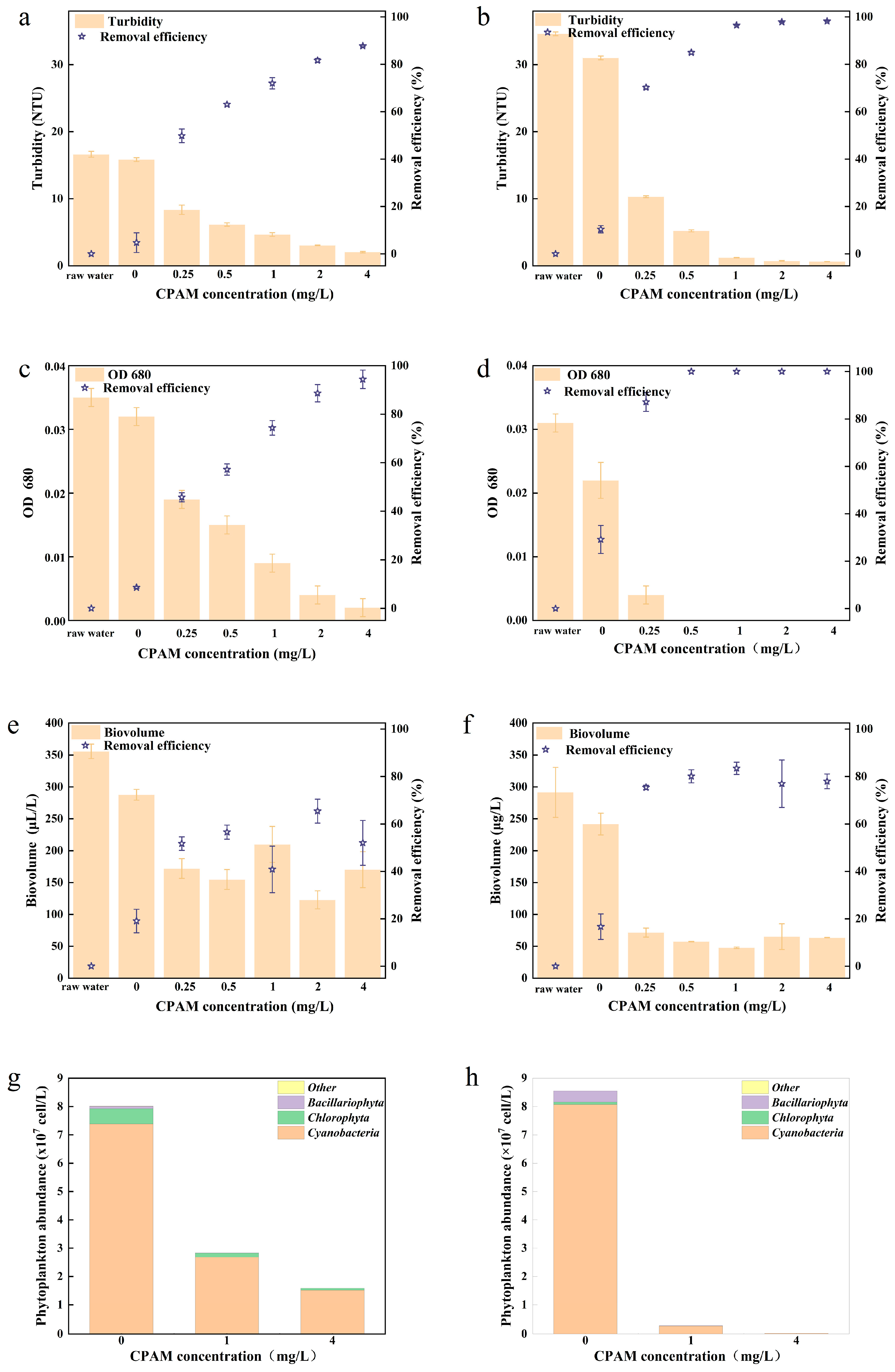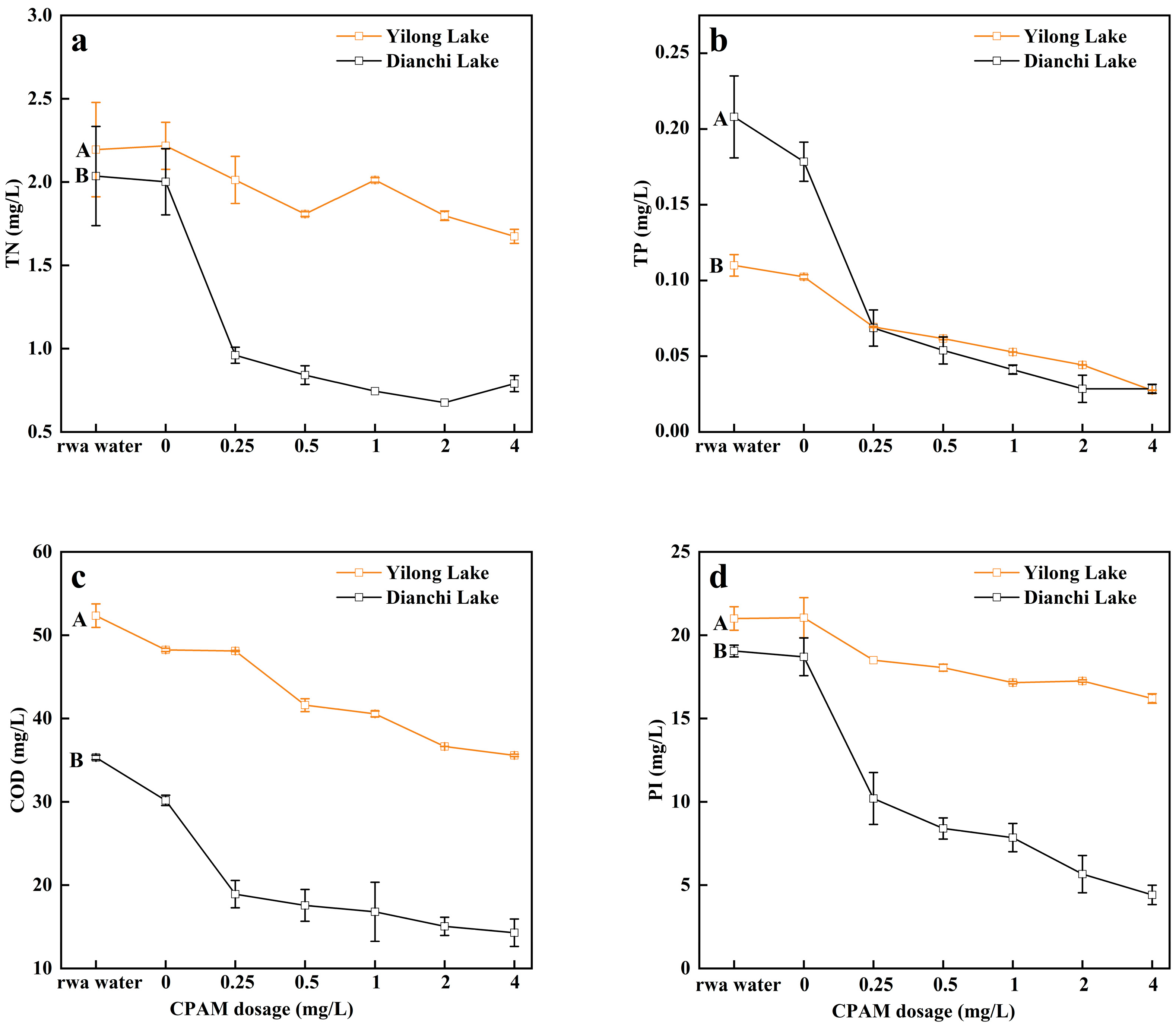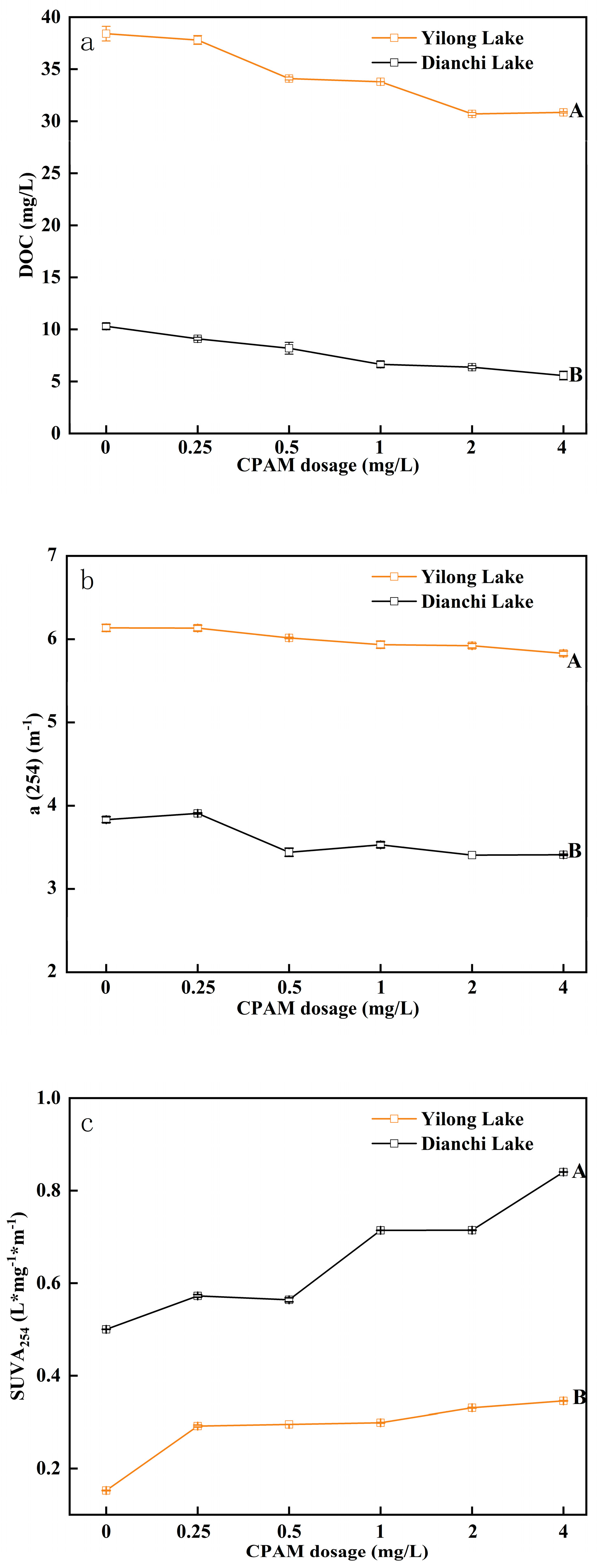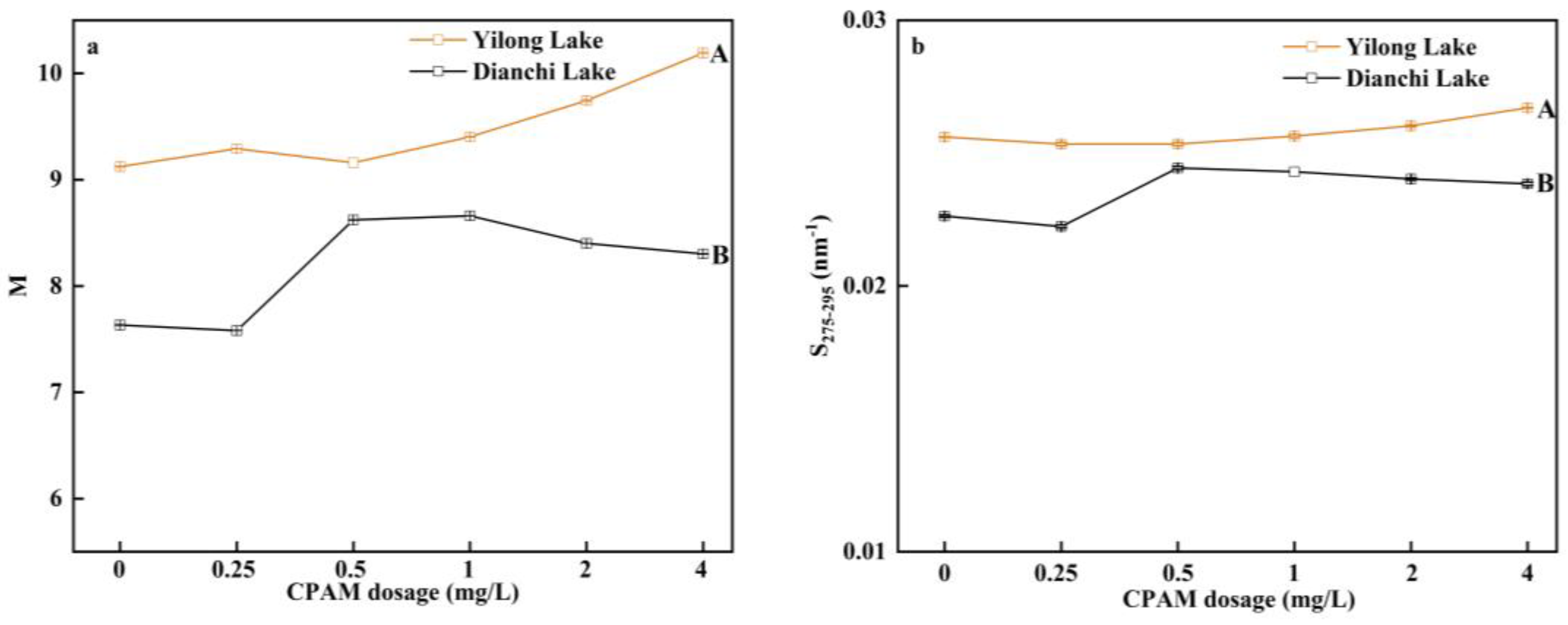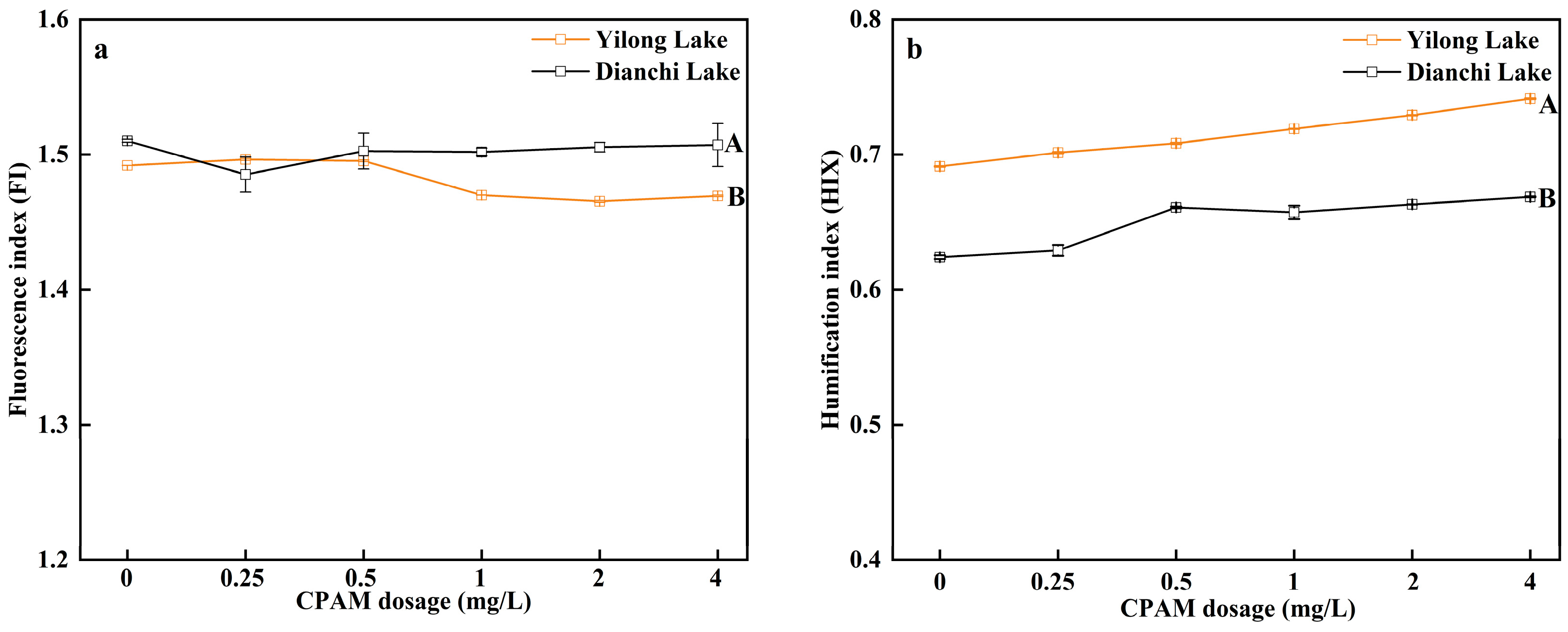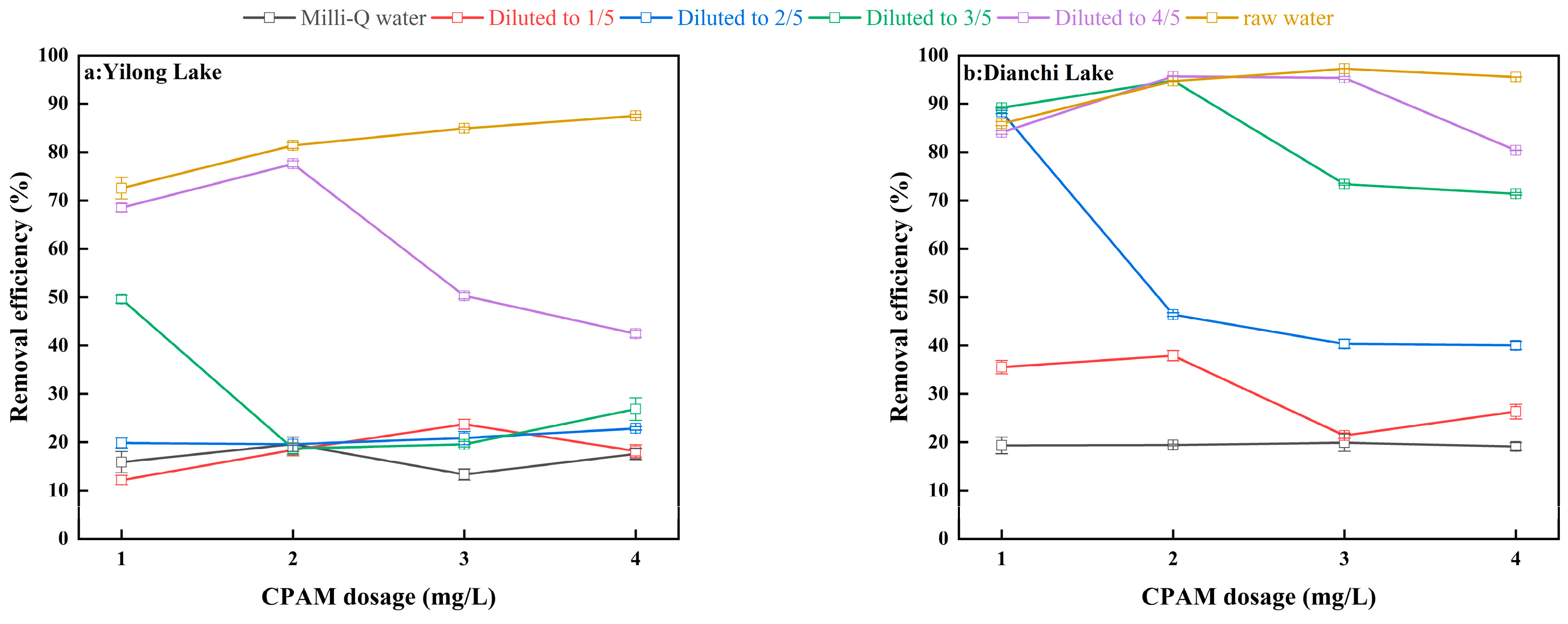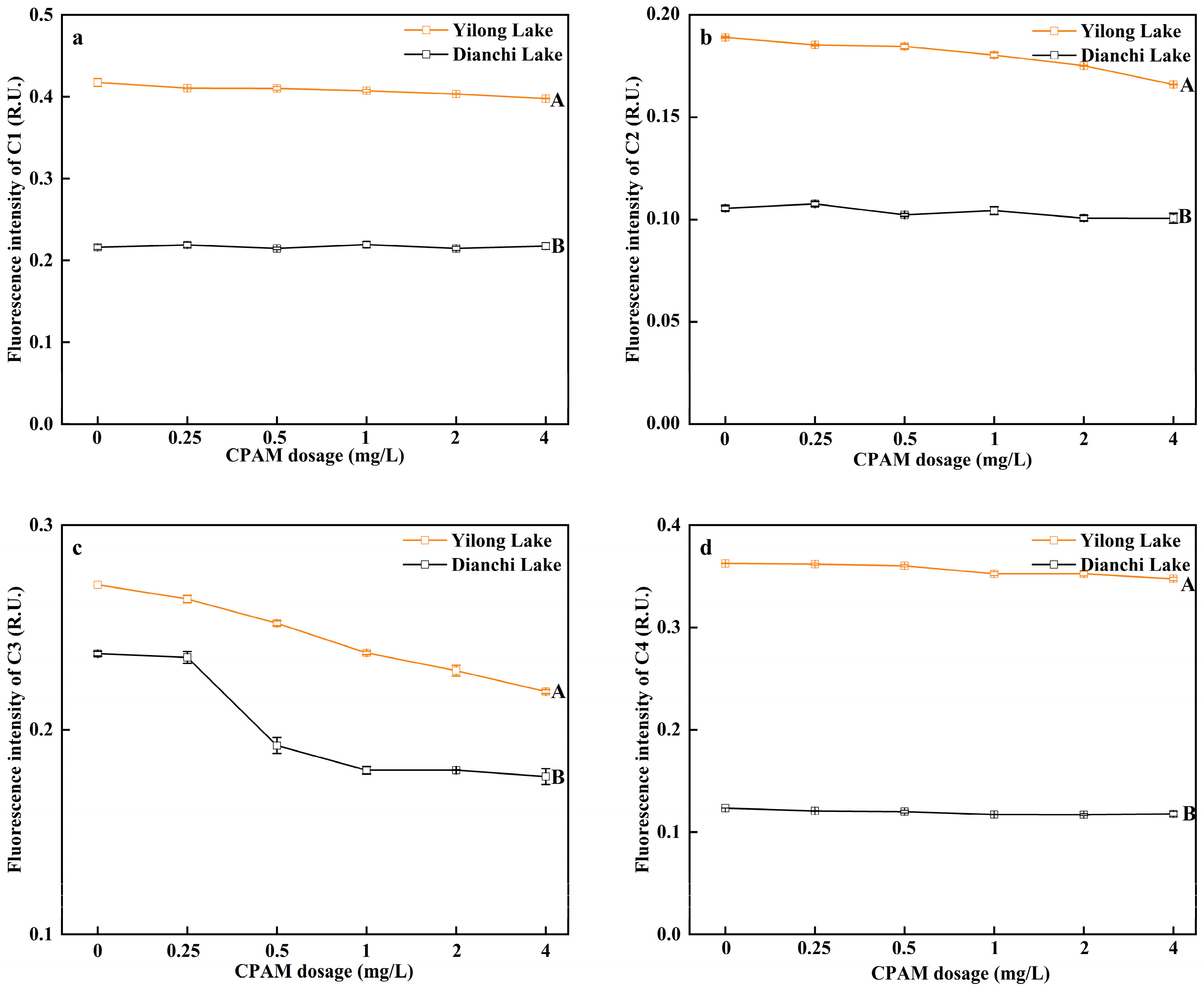3.1. Phytoplankton Removal Efficiency of the Flocculation–Filtration Treatement
Water samples from Yilong Lake have a turbidity of 16.64 NTU and an OD 680 of 0.035 Abs (
Figure 1a,c). When filtered through a 100 μm sieve without the addition of flocculant (0 mg/L CPAM), the turbidity and OD 680 only decreased by 4.76% and 8.58%, respectively. As the flocculant dosage increased, the effluent turbidity and OD 680 gradually decreased. With 1 mg/L CPAM, the turbidity decreased by 72.04%, and the OD 680 decreased by 74.35%. With 4 mg/L CPAM, the turbidity was reduced to lower than 2.04 NTU, achieving a removal rate of approximately 87.74%. Water samples from Dianchi Lake have a turbidity of 34.6 NTU and an OD 680 of 0.031 Abs (
Figure 1b,d). After being filtered without the addition of flocculant, the turbidity and OD 680 only decreased by 10.39% and 29.17%, respectively. With 0.25 mg/L CPAM, the turbidity decreased to lower than 10 NTU. With 0.5 mg/L CPAM, the removal of turbidity and OD 680 increased to 85.04% and 100%, respectively. In the presence of 1–4 mg/L CPAM, the turbidity of the treated water was consistently lower than 2 NTU. Therefore, for water from Dianchi Lake, 1 mg/L CPAM was enough for a reduction of 95% of turbidity, while for water from Yilong Lake, even 4.0 mg/L CPAM was not enough as to obtain a removal efficiency higher than 90%. Furthermore, the removal efficiency of turbidity was higher than that of OD680.
Biovolume was also used to reveal the removal of phytoplankton particles (
Figure 1e,f). The biovolume of raw water from from Yilong Lake was 356 μL/L and reduced to 288 μL/L when filtered through a 100 μm sieve in the absence of flocculants. After the flocculation–filtration treatment, the biovolume reduced to 120–210 μL/L, with a removal efficiency of 41.0–66.3%. As for Dianchi Lake, the biovolume reduced from 290 μL/L in the raw water to 50–70 μL/L, with a removal efficiency of 75.8–82.7%.
In Yilong Lake, 5 phyla and 42 species of phytoplankton were identified (
Figure 1g). Among them,
Cyanobacteria were the predominant group, with a cell density of 7.39 × 10
7 cells/L, constituting 92.19% of the total cell density.
Bacillariophyta had a cell density of 9.00 × 10
5 cells/L, accounting for 1.12% of the total cell density, and
Chlorophyta had a cell density of 5.32 × 10
6 cells/L, making up 6.63% of the total cell density. In Dianchi Lake, phytoplankton from 4 phyla and 43 species were identified (
Figure 1h). The cell density of
Cyanobacteria was 8.07 × 10
7 cells/L, representing 94.39% of the total cell density. The cell density of
Chlorophyta was 3.93 × 10
6 cells/L, accounting for 4.60% of the total cell density.
Bacillariophyta had a cell density of 8.53 × 10
5 cells/L, making up 1.00% of the total cell density. The cell abundances of phytoplankton in Yilong Lake and Dianchi Lake were 8.02 × 10
7 cells/L and 8.55 × 10
7 cells/L, respectively. After flocculation with 1 mg/L CPAM, the phytoplankton density in Yilong Lake and Dianchi Lake decreased to 2.85 × 10
7 and 2.85 × 10
6 cells/L, respectively. With 4 mg/L CPAM, the removal efficiency of phytoplankton cells was greater than 80% in Yilong Lake and approximately 99.70% in Dianchi Lake.
In this study, turbidity, OD680, biovolume and phytoplankton density were used to reveal the treatment efficiency. OD680 is commonly used to represent cell density, and the degree of its reduction is often used to indicate phytoplankton removal efficiency [
14]. For natural waters, turbidity is popular because it encompasses both suspended particles and colloidal organic matter [
15]. The accuracy of chl-a and biovolume in representing phytoplankton biomass has been a topic of ongoing debate [
16]. However, due to the convenience and speed of biovolume measurement, this study opted to use biovolume to represent changes in phytoplankton biomass. Additionally, phytoplankton composition and biomass were also used to reflect the changes before and after treatment in this study. The removal efficiency of OD680 was consistent with that of phytoplankton density, both of which were higher than that of turbidity. The possible reason was that the removal efficiency of phytoplankton was higher than that of colloidal particles. The residual colloidal particles in the treated water were reflected in turbidity but were not reflected in OD680. The determination of biovolume is based on laser particle size analyzer, and the accuracy of measurement is influenced by the shape and hardness of particles. When used to indicate phytoplankton removal rates, its accuracy might be lower compared to OD680 and turbidity. If the focus was solely on phytoplankton removal, OD680 might have been the most convenient indicator. However, since colloidal particles in the lake also needed to be removed, in the subsequent experiments of this study, turbidity was the primary indicator to represent the removal efficiency.
Regardless of the indicator used, the treatment efficiency of flocculation and filtration in Dianchi Lake far exceeds that in Yilong Lake. The disparities in DOM as well as phytoplankton abundance and characteristics between the two lakes may account for the differences in treatment efficiency. This study predominantly investigated the causes and mechanisms behind the less effective treatment of Cylindrospermopsis blooms in Yilong Lake, focusing on DOM analysis.
3.2. Water Quality Improvement by the Flocculation–Filtration Treatement
Upon removal of cyanobacteria particles, there was a noticeable enhancement in water quality, further amplified with higher flocculant dosages (with a few exceptions). In the raw water from Yilong Lake, TN, TP, COD, and PI concentrations were 2.20 mg/L, 0.11 mg/L, 52.34 mg/L, and 21.00 mg/L, respectively (
Figure 2). After treatment with 0.25 mg/L of CPAM, TP removal reached 22.22%, while other indicators were reduced by approximately 10 ± 2.5%. At 2 mg/L CPAM, removal rates for TN, TP, PI, and COD were 17.83%, 50.78%, 18.10%, and 32.02%, respectively. Increasing CPAM dosage to 4 mg/L lowered TN, TP, PI, and COD to 1.67 mg/L, 0.02 mg/L, 35.57 mg/L, and 16.20 mg/L, respectively.
Just like the cyanobacteria removal efficiency, after the flocculation–filtration treatment, the improvement in water quality in Dianchi Lake is significantly better than in Yilong Lake. The concentrations of TN, TP, COD and PI in the raw water of Dianchi Lake were 2.04 mg/L, 0.21 mg/L, 35.33 mg/L, and 19.05 mg/L, respectively. After adding 0.25 mg/L of CPAM, the removal rates for these indicators exceeded 46.45%, with TP removal exceeding 67%. At 1 mg/L CPAM dosage, the removal rates for TN, TP, PI, and COD reached 63.43%, 80.21%, 58.79%, and 52.45%, respectively. With CPAM dosages between 2–4 mg/L, the removal rates for these indicators were above 70.29%, 57.38%, 61.19%, and 86.30%, respectively. Consistent with the cyanobacteria removal efficiency, the water quality improvement after treatment was significantly superior in Dianchi Lake compared to Yilong Lake (two factors analysis of variance, p < 0.001). Following the flocculation–filtration treatment, Dianchi Lake exhibited a substantial improvement in water quality, with reductions of over 50% in TN, TP, PI, and COD. In contrast, the reduction in nutrient levels was limited in Yilong Lake.
3.3. Changes in Indicators Reflecting the Concentration and Characteristics of DOM
The initial DOC concentrations in Yilong Lake and Dianchi Lake were 38.0 mg/L and 10.3 mg/L, respectively (
Figure 3a). After flocculation with different CPAM dosages, there was a significant reduction in DOC concentrations. However, the treated water still exhibited relatively high DOC levels, particularly in Yilong Lake. With 4 mg/L CPAM, the DOC concentration decreased by 8 mg/L in Yilong Lake and 4.5 mg/L in Dianchi Lake. The DOC concentration of Yilong Lake was significantly higher than that of Dianchi Lake. It has been reported that DOM may hinder the flocculation of CPAM or consume more flocculants [
17,
18]. The high DOC concentration may been the main reason for the non-effectiveness of the flocculation of water of Yilong Lake.
The a
254 serves as an indicator of color dissolved organic matters in natural water [
10]. Following the flocculation–filtration treatment, the a
254 value of Yilong Lake gradually decreased with increasing flocculant dosage (
Figure 3b). However, even with 4 mg/L of CPAM, the a
254 value of Yilong Lake only reduced from 6.1 m
−1 to 5.8 m
−1, indicating a 4.9% reduction. Similar patterns were observed in Dianchi Lake; after flocculation with CPAM dosages ranging from 0.5 to 4 mg/L, the a
254 value decreased from 3.8 m
−1 in the raw water to 3.4 m
−1, indicating a 10.5% reduction. Given the limited removal of DOM by flocculation, as evidenced by DOC concentration, the constrained removal of color dissolved organic matters is expected.
SUVA
254 is an indicator of the aromaticity of DOM. Higher SUVA
254 values indicate greater aromaticity, suggesting a higher proportion of unsaturated organic compounds and a higher degree of humification [
19]. The SUVA
254 value of Dianchi Lake was significantly higher than that of Yilong Lake. After flocculation, SUVA
254 increased from 0.15 L·mg
−1·m
−1 in the raw water of Yilong Lake to 0.35 L·mg
−1·m
−1, highlighting the increase of aromaticity after the treatment.
Both the M value and the slope S
275–295 serve as indicators of the relative size of the molecular weight of DOM and are typically exhibit a negative correlation with the average molecular weight of DOM [
20]. Following treatment, both the M value and S
275–295 increased significantly (
p < 0.01,
Figure 4), signifying the selective removal of high molecular weight DOM. The notably higher M value and S
275–295 observed in Yilong Lake in comparison to Dianchi Lake indicate that the average molecular weight of DOM in Yilong Lake was considerably smaller than that in Dianchi Lake (
p < 0.001). Previous studies have highlighted the pivotal role of large molecular DOM (e.g., molecules with a molecular weight greater than 100 kDa) in CPAM flocculation [
10]. Insufficient presence of large molecular DOM could diminish flocculation effectiveness. Despite its high organic matter content, Yilong Lake’s DOM had a small molecular weight. This factor might contribute to its comparatively less effective flocculation compared to Dianchi Lake.
FI serves as an indicator of DOM origin, reflecting the ratio between microbial and terrestrial sources. A smaller value (<1.2) indicates an external origin of DOM, while a higher value (>1.8) suggests a microbial source of DOM [
20]. The FIs for the raw water of Yilong Lake and Dianchi Lake were 1.49 and 1.51, respectively (
Figure 5). Falling between 1.2 and 1.8, these values suggest significant contributions from both terrestrial and biological organic matter to the DOM composition in both lakes. Following flocculation with 1–4 mg/L CPAM and filtration through 100-μm sieves, the FI significantly decreased, indicating the removal of more microbial-sourced DOM. However, in the case of Dianchi Lake, the FIs before and after treatment remained largely unchanged. Additionally, the HIX of Yilong Lake gradually increased after treatment. In Dianchi Lake, the HIX increased significantly when the CPAM concentration reached 0.5 mg/L, with no significant difference observed between 0.5–4 mg/L CPAM concentrations. HIX embodies the essence of aromaticity, indicating that DOM originates from either biological or aquatic bacterial sources when its value is less than 4, and signifies a pronounced humic component when surpassing 16 [
11]. In previous studies, it was observed that proteins and polysaccharides were selectively removed through CPAM flocculation, while humic substances remained unaffected. This phenomenon could explain the observed increase in SUVA
254 and HIX values [
9].
Four fluorescent components were recognized in the 3D-EEM spectrums, comprising one protein-like component and three humic-like components (
Figure S1 in Supplementary Materials). C1 exhibited maximum excitation/emission wavelengths (Ex/Em) at 305(225)/395 nm, resembling the humic substance with M-peak characteristics first discovered in oceans. This peak is widely distributed in marine and terrestrial water bodies, closely related to phytoplankton productivity and microbial activity, often referred to as microbial humic-like components [
10,
21]. C2 with Ex/Em at 285(380)/486 nm was defined by Stedmon as fulvic acid-like substances, representing a typical UVB-type humic substance component. It is usually found in agriculturally dominated watersheds and consists of fulvic acid fluorescence groups from terrestrial/local sources, correlating with soil organic matter humic content and widespread in various freshwater environments [
22]. C4 with Ex/Em at 350(265)/442 nm is a common UVA-type humic substance, exhibiting spectral characteristics similar to humic substance C-peak. It is typically present in marine and terrestrial water bodies, originating from anthropogenic activities and microbial degradation processes. C3 with Ex/Em at 280(220)/318 nm possesses fluorescence properties similar to tyrosine, and is often termed protein-like fluorescence.
Following the flocculation–filtration treatment, all four fluorescent components in Yilong Lake gradually decreased with increasing flocculant dosage. At 4 mg/L of CPAM, the fluorescence intensity C3 reduced by 19.8%, while that of C1, C2, and C4 reduced by 4~13%. In Dianchi Lake, the fluorescence intensity of C3 decreased by 18%~26%, while the other fluorescence components showed slight or no reduction after flocculation with 0.5–4 mg/L CPAM. As C3 represents the abundance of the protein-like component, it could be inferred that the protein was significantly removed. The reduction of humic-like component (referred to as C1, C2, and C4) was significantly lower than that of protein-like component. A previous study has confirmed—through protein staining and confocal microscopy observations—that proteins participated in CPAM flocculation and become part of the flocs [
10]. Humic substances do not seem to enhance CPAM flocculation. However, as both humic substances and algal cells are negatively charged, whether humic substances interfere with cyanobacteria flocculation requires further research.
3.4. Influence of DOM on the Treatment
Previous studies have shown that the primary factor influencing flocculation in lakes is dissolved organic matter (DOM) [
10]. Other substances, such as multivalent cations, when present at natural water concentrations, are unlikely to affect CPAM flocculation. Yilong Lake’s DOC concentration exceeds that of Dianchi Lake by 3.1 times, suggesting an excessively high DOC content as a likely cause for Yilong Lake’s low flocculation efficiency. Consequently, a systematic gradient dilution approach was employed to reduce DOC concentration in lake water, exploring its effect on flocculation efficiency (
Figure 6).
For the filtered water of Yilong Lake with the addition of kaolin particles, the removal efficiency increased from 71% to 88% when the dosage of CPAM increased from 1 mg/L to 4 mg/L. When the lake water was diluted to 4/5 and the DOC concentration was diluted from 38.2 mg/L to 30.56 mg/L, the removal efficiency slightly decreased at CPAM dosages of 1 mg/L and 2 mg/L, dropping to 68.5% and 77.5%, respectively. At CPAM dosages of 3–4 mg/L, removal efficiency markedly decreased to lower than 55%. Further dilution of Yilong Lake water to 1/5–3/5 mg/L DOC resulted in a more significant reduction in removal efficiency. Specifically, at a DOC concentration of 22.92 mg/L (diluted to 3/5), removal efficiency decreased to 50% at 1 mg/L CPAM and dropped below 30% at 2–4 mg/L CPAM. At a DOC concentration of 7.64–15.28 mg/L (diluted to1/5–2/5), removal efficiency remained below 30% at CPAM dosages of 1–4 mg/L. Therefore, the flocculation efficiency of the raw water from Yilong Lake remained below 90%, and lowering the DOC concentration of the lake water did not improve the flocculation efficiency. On the contrary, even when diluted to 4/5, the flocculation efficiency was drastically reduced. Diluted to 3/5 or lower, Yilong Lake water became ineffective for flocculation. Moreover, there was a correlation between DOC concentration in the lake water and the optimal flocculant dosage. For the original Yilong Lake water, the optimal dosage was 4 mg/L or higher. However, by diluting it to 4/5, the optimal CPAM dosage decreased to 2 mg/L. Higher flocculant concentrations (3–4 mg/L CPAM) actually reduced flocculation efficiency.
In Dianchi Lake’s filtered water with added kaolin particles, removal efficiency was 85.9% at 1 mg/L CPAM, reaching 95–98% at CPAM doses from 1 to 4 mg/L. Upon dilution to an 8.24 mg/L DOC (diluted to 4/5), the removal efficiency decreased to 84% at 1 mg/L CPAM and 80% at 4 mg/L CPAM, with a minimal change at 2–3 mg/L CPAM. At 6 mg/L DOC (diluted to 3/5), the removal efficiency remained high at 90% with 1–2 mg/L CPAM, dropping to below 80% at 3–4 mg/L CPAM. When diluted to 0–2 mg/L DOC, the removal efficiency stayed under 40% at CPAM doses of 1–4 mg/L. Similarly, after dilution of the water from Dianchi Lake, the flocculation efficiency also decreased. Although an adequate amount of DOC is crucial for CPAM flocculation [
10] and the DOC concentration in Dianchi Lake was significantly lower than that in Yilong Lake, the reduction in flocculation efficiency through dilution was lower in Dianchi Lake compared to Yilong Lake. Additionally, the relationship between DOC concentration and flocculant dosage was more significant in Dianchi Lake than in Yilong Lake. When the water from Dianchi Lake was diluted to 2/5 (4 mg/L DOC), the removal efficiency with 1 mg/L of flocculant was 88%. However, with higher dosage of flocculant, the removal efficiency decreased to below 50%.
Comparing the results from Yilong Lake and Dianchi Lake, it was evident that it was not just the concentration of DOM in lakes, but the specific components within it significantly influenced flocculation effectiveness. The deficiency of these key components (such as in diluted lake water) drastically reduced flocculation efficiency. Previous studies had indicated that these crucial components included proteins and polysaccharides [
9,
10]. In comparison to Dianchi Lake, Yilong Lake had slightly higher protein content and lower polysaccharide content (not provided), but the content of humic substances in Yilong Lake was much higher than in Dianchi Lake (
Figure 7). The minor differences in protein and polysaccharide concentrations could not adequately explain the disparity in flocculation efficiency between the two lakes. The lower flocculation efficiency in Yilong Lake might be attributed to the presence of humic substances.
3.5. Influence of Humic Acid on the Removal Efficiency
To investigate the influence of humic substances on flocculation, a humic acid standard was introduced into lake water, and flocculation efficiency was examined under varying concentrations of humic acid. After the flocculation–filtration treatment, turbidity reduction was analyzed to assess the influence of humic acid (
Figure 8).
The addition of humic acid substantially decreased the removal efficiency in Yilong Lake. In the absence of humic acid, the removal efficiency ranged from 82% to 89% for Yilong Lake at CPAM dosages of 1 mg/L to 4 mg/L. However, in the presence of 2.5 mg/L humic acid, the removal efficiency decreased to 49% at 1 mg/L CPAM and 81% at 4 mg/L CPAM. With higher concentrations of humic acid, the removal efficiency dropped to below 60%. This clearly indicates that humic acid significantly reduced removal efficiency and increased the consumption of flocculants. Similar findings were reported by Sanabria et al. (2013), who observed a seven-fold increase in CPAM consumption (from 3 mg/L to 20 mg/L) [
19], due to the presence of DOM in the algae culture. CPAM, being a cationic flocculant with numerous quaternary ammonium groups, experienced an increase in dosage due to the binding of carboxyl groups from humic acid, thereby escalating the need for flocculants.
The Inhibitory effect of humic acid on flocculation was also observed in Dianchi Lake. Without the addition of humic acid, the removal efficiency was 95–98%. In the presence of 2.5 mg/L humic acid, the removal efficiency decreased to 71% at 1 mg/L CPAM and 94.6% at 4 mg/L CPAM. Higher humic acid concentrations led to more pronounced inhibition. The inhibitory effect of humic acid on Dianchi Lake was less pronounced than on Yilong Lake. This might be because the flocculation in Yilong Lake was already affected by humic substances in the water. The additional introduction of humic acid further intensified this inhibitory effect. Furthermore, despite the inhibition of flocculation in Dianchi Lake by humic acid, a removal efficiency above 90% could still be achieved by increasing the flocculant dosage. However, excessively high dosages of flocculants are not recommended.
This study demonstrated that excessively high content of humic matters significantly hampers cyanobacteria flocculation in Yilong Lake. To address this challenge, one proposed solution involves the introduction of additional organic compounds known to enhance flocculation. For instance, Cai et al. (2021) showcased the effectiveness of integrating acidic polysaccharides like xanthan gum, leading to a substantial increase in the efficiency of quaternary ammonium salt-based flocculants [
23]. Another viable approach entails the integration of oxidation with flocculation. This involves an initial step of oxidizing a portion of the humic acid through the introduction of specific oxidizing agents. Pre-oxidation-assisted flocculation has been extensively explored, employing various agents such as calcium peroxide [
24], potassium permanganate [
25], potassium ferrate [
26], and ClO
2 [
27,
28]. Particularly for water bodies affected by
Cylindrospermopsis blooms, pre-oxidation emerges as a promising avenue to enhance flocculation efficiency. In subsequent studies, we will conduct in-depth investigations to assess the effectiveness of these strategies in improving flocculation in Yilong Lake water.
